2½-ton 6x6 truck
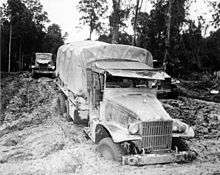

The 2 1⁄2-ton 6x6 truck, also known by the nickname deuce and a half, or just deuce, was a standard class of medium duty trucks designed for the US Armed Forces, that served from 1940 through the 1990s.[nb 1] The basic cargo versions were designed to transport a cargo load of nominally 2 1⁄2 short tons (5,000 lb / ca. 2.25 metric tons) over all terrain, in all weather. Additionally, a minority of the trucks were built minus the front-wheel drive.[nb 2] The 2 1⁄2-ton trucks were used ubiquitously in World War II, and continued to be the U.S. standard medium duty truck class after the war, including wide usage in the Korea and Vietnam Wars, as well as the first Gulf War.
Originally, five different designs were standardized by the U.S.; two were also standardized by Canada. During World War II the most important model for the US Army was the GMC CCKW or "Jimmy", with over 560,000 units built. Another 200,000+ deuces were Studebaker and REO US6, built primarily for Lend-Lease export, mostly to the Soviet Union, and many others have been exported to smaller militaries.
After World War II, the M35 series truck, originally developed by REO, became the standard 2 1⁄2-ton truck. First fielded in the 1950s, the M35 family became one of the most successful and long-lived series of trucks ever deployed by the U.S. military. They served in Vietnam and continued to serve with various modifications into the late 1990s.[2] The U.S. began replacing the 2 1⁄2-ton 6x6 and 6x4 trucks with the light medium, 4x4, LMTV variants of the Family of Medium Tactical Vehicles (FMTV) in 1991.
Of the almost 2.4 million trucks that the U.S. Army bought between 1939 and December 1945 (across all payload weight classes), just over one third (~812,000) were 2 1⁄2-ton trucks, the vast majority of which (over 675,000 units) were six by six variants – outnumbering the almost 650,000 World War II jeeps.[1] A further ~118,000 2 1⁄2-ton trucks were built as 6x4 driven units.
The 2 1⁄2-ton cargo truck was considered such a valuable equipment that General Eisenhower wrote that most senior officers regarded it as one of the six most vital U.S. vehicles to win the war.[nb 3] It has been called the most important truck of World War II, and the 6x6 became known as the "workhorse of the army".[1] According to Hyde (2013): "Each of the three axles had its own differential, so power could be applied to all six wheels on rough terrain and steep hills. The front axle was typically disenganged on smooth highways, where these "workhorses" often carried loads much above their rated capacity." [1]
Half a century after World War II, the remanufactured 2 1⁄2-ton M35 trucks still met 95 percent of the performance requirements at 60 percent of the cost of a new FMTV vehicle.[2]
History
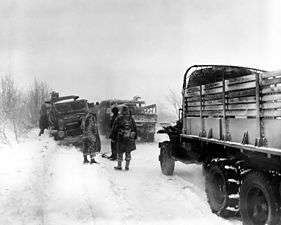
In 1939-1940 the US Army Ordnance Corps was developing a 2 1⁄2-ton (2,268 kg) load-rated 6×6 tactical cargo truck that could operate off-road in all weather. Dump, semi-tractor, tanker, and other bodies were also planned.[4][5]
Yellow Coach (a GM company), Studebaker, International Harvester, and REO submitted designs, all except REO's were accepted and in production by 1941. Yellow’s CCKW became the Army standard, International’s M-5-6 became Navy and Marine Corps standard, and Studebaker’s US6 was built for export to allied countries. Reo built the Studebaker design.[5][6][7][8]
In the late 1940s the military needed a new standard truck. Chrysler, GMC, REO, and Studebaker submitted designs. The REO design was standardized for all services as the M35, and continued standard until 1990. The GMC was classed as substitute standard M135 in the US but became standard in Canada.[9][10]
Designs


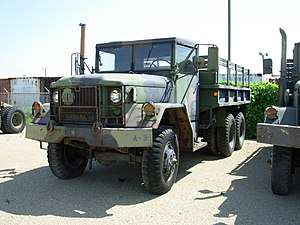

GMC CCKW
As the standard US Army design during World War II, over 560,000 were built, more than any other US vehicle except the "Jeep". By 1947 there were over 20 standardized bodies, and many more special modifications.
Production began at Yellow Coach’s Pontiac, Michigan truck plant in 1941 and at Chevrolet’s St. Louis plant in 1942. In 1943 Yellow was renamed G.M.C., leading to the popular nickname "Jimmy". Production ended in 1945.
Early trucks had GM’s standard closed cab, from July 1943 military open cabs, which were easier to build and lowered shipping height, were used. To conserve steel, later cargo bodies were built largely of wood. The C.O.E. AFKWX, 6x4 CCW, and amphibious DUKW were mechanically virtually identical and were built next to CCKWs in both plants.[11][12][13][14][15]
Studebaker US6
The US6 was very similar in layout to, and shared some components with, the CCKW. Studebaker built over 195,000 at their South Bend, Indiana plant between June 1941 and August 1945, REO built another 22,000 in 1944-1945. The majority were exported Lend-Lease to the Soviet Union.
Early trucks used a commercial style closed cab, in December 1942 an open military style cab entered production. The Soviet Union preferred the closed cabs for their extreme weather, so in March 1943 the open cabs were discontinued, after only about 10,000 were built.
The Studebakers were very successful in the Soviet Union, where they carried large loads on poor roads in extreme weather. They were so successful that they were closely copied as the ZiS/ZiL 151 and 157 family of trucks, built in the USSR until 1966 and in China until 1986.[16][17][18][19][20]
IHC M-5-6
The International design began production at Ft. Wayne, Indiana, in 1941. 500 M-5-6s and 3,000 M-5-6x4s, with a commercial K model cab, were complete by 1942, and were exported to the Soviet Union. The design then was upgraded, with a larger engine, tires, military open cab, and other improvements, and standardized as the M-5H-6 for the US Navy and Marines. The only 2 1⁄2-ton with locking differentials, it had excellent off-road performance. More than 30,000 of all models were built between 1941-1945.[21][22][23][24][25]
REO M35
The standard post-war 2 1⁄2-ton truck M35 was manufactured by AM General, Bombardier (Canada), Curtis-Wright, Kaiser-Jeep, REO, Studebaker, and Studebaker-Packard from 1950 until the late 1980s, with remanufacture extending into FY1999. The M35 has had the widest range of bodies of any US truck. The cab design itself became the military standard, also used by 5 and 10-ton trucks. First built with a gasoline engine, in 1964 the multi-fuel became standard. In 1991 existing M35s began to be upgraded with diesel engines and automatic transmissions. Canadian trucks had automatic transmissions as built.[26][27][28]
GMC M135
After the REO M35 was standardized GMC submitted a different design. An evolution of the CCKW, the GMC was classed as substitute standard M135 in the US but was widely used by the Canadian Army called the Deuce and a Half.
M135 was the only 2 1⁄2-ton truck designed with an automatic transmission. The transmission had 4 speeds and 2 ranges, with a single range transfer case.[29][30][31]
Bodies
Cab
All of the 1940 designs had commercial type closed cabs with minor modifications. Variants had an open passenger roof so a ring for a .50 caliber machine gun could be mounted, during World War II approximately one in four trucks had a ring. In 1942, to simplify production and reduce shipping height, all manufacturers began to use military style open cabs. Studebaker returned to closed cabs after only 10,000 open cabs were built because the major user USSR preferred closed cabs. The post-war M35 and M135 were designed with open cabs and half-doors. Most military cabs could mount a machine gun ring. The M35 and M135 had removable hard tops available.[32][33][34]
Cargo Trucks
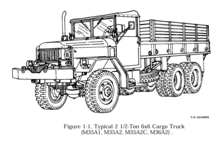
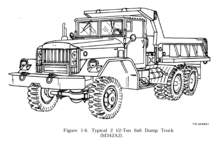



All series had a cargo model with a 12 ft (3.66 m) body on a long wheelbase. The 1940 designs had a 9 ft (2.74 m) prime mover type body on a short wheelbase, the M35 series had a 17 ft 5 in (5.31 m) body on an extra long wheelbase.
All models had removable sideboards and overhead bows for a tarpaulin over the cargo area. All except the extra long M36 had folding troop seats in the sideboards.
Late in World War II, to conserve steel, cargo bodies were made largely of wood, postwar the M35 and M135 series returned to steel.[35][36][37][38]
Dump Trucks
All series had dump trucks on a short wheelbase. The US6 also had side-dump trucks. The cab stone-shield could be removed on most to lower shipping height. They could be equipped with overhead bows, tarpaulin, and troop seats.[39][40][41][42]
Tractor Trucks
The M-6H-6, M211, and M35 series had a semi-tractor on a short wheelbase, the M35 series also had a long tractor. GMC made a few tractors based on the CCKW 352[43] during World War II. Studebaker never built a 6x6 tractor but built a 6x4 model.
Semi-tractor/trailers have limited off-road performance, and are not rated for full off-road use. The M35 and M211 series fifth wheel load rating was 12,000 lb (5,400 kg) on road and 7,000 lb (3,200 kg) off-road. A 36,000 lb (16,000 kg) trailer could be towed on road and a 17,000 lb (7,700 kg) trailer off-road.[39][44][45][46]
Tanker Trucks
All series had fuel and/or water tanker versions on long wheelbases. Capacities were 750 US gal (2,800 l) to 1,200 US gal (4,500 l) in 2 or 3 compartments, depending on the series and whether carrying gasoline, water, or other liquid. Most had pumps and some had heaters. Most World War II could be fitted with bows and a tarpaulin to camouflage themselves as common cargo trucks.[33][34][47]
Van Trucks
The CCKW, M35, and M135 had a 12 ft (3.66 m) van model on a long wheelbase. These could be equipped for many different roles. The M35 also had a 17 ft (5.18 m) model with slide out sections on both sides. Van bodies were used for medical, communication, machine, repair, and other shops.They could have different sizes, window arrangements, and other special equipment. "Expansible" vans are used for communication equipment.[48][49][50] 270-276
Chassis cabs
The GMC CCKW and M35 series had chassis cabs in different wheelbases for specialty bodies. Maintenance, engineer, water purification, pole-setting, air compressors, fire fighting, and other equipment were also mounted on chassis cabs.[51][52][53][54]
Footnotes
- ↑ Originally, during World War II, categorized as a light-heavy truck. [1]
- ↑ The term 'six by six' must not be taken too literally — the vast majority of the 2½-ton trucks had ten wheels — what is meant is three axles, with driving power being available to all six axle-ends.
- ↑ The others being the bulldozer, the Landing Ship, Tank, the amphibious "Duck" truck, the jeep, and the C-47 airplane.[3]
Reference notes
- 1 2 3 4 Hyde, Charles K. (2013). Arsenal of Democracy: The American Automobile Industry in World War II. Wayne State University Press. p. 152–153. ISBN 9780814339527.
- 1 2 M-35 Series 2 1_2-ton, 6x6 Trucks (G-742) – Olive-Drab
- ↑ Dwight D. Eisenhower (1948). Crusade in Europe. Doubleday (US) / Heinemann (UK). p. 163/164. ISBN 080185668X. OCLC 394251.
- ↑ Crismon (2001), p. 8, 326-327, 329.
- 1 2 Ware (2014), p. 236, 238-239.
- ↑ Crismon (1995), pp. 164-165.
- ↑ Crismon (2001), pp. 327-334.
- ↑ Doyle (2003), pp. 108, 122, 125.
- ↑ Crismon (2001), pp. 335-338.
- ↑ Doyle (2003), pp. 127-128, 156.
- ↑ Crismon (2001), pp. 330-334.
- ↑ Doyle (2003), pp. 105-121.
- ↑ Hyde (2014), pp. 203-207.
- ↑ Ware (2014), pp. 237-239.
- ↑ TM 9-801 (1944).
- ↑ Crismon (2001), pp. 328-329.
- ↑ Doyle (2003), pp. 122-124.
- ↑ Ware (2014), p. 111, 181.
- ↑ Hyde (2014), pp. 65-67, 208-209.
- ↑ TM 9-807 (1943).
- ↑ Crismon (1995), pp. 164-165, 170, 178, 185,.
- ↑ Crismon (2001), pp. 327-328.
- ↑ Doyle (2003), pp. 125-127.
- ↑ Hyde (2014), pp. 209.
- ↑ Ware (2014), p. 236.
- ↑ Crismon (2001), pp. 338-345.
- ↑ Doyle (2003), pp. 127-155.
- ↑ TM 9-2320-361-10 (1993).
- ↑ Crismon (2001), pp. 336-337.
- ↑ Doyle, 2003 & 156-160.
- ↑ TM 9-8024 (1955).
- ↑ Doyle (2003), pp. 110, 122, 127, 158.
- 1 2 TM 9-500 (1953), pp. 21-83 to 21-90.
- 1 2 TM 9-2800 (1947), pp. 279-281.
- ↑ Ware (2014), pp. 236, 238-329.
- ↑ Doyle (2003).
- ↑ TM 9-500 (1953), pp. 6-10.
- ↑ TM 9-2800 (1947), pp. 266, 273-275.
- 1 2 Crismon (1995), pp. 185.
- ↑ Doyle (2003), pp. 111-112,124-125,132-134, 158.
- ↑ TM 9-500 (1953), pp. 21-69, 21-74.
- ↑ TM 9-2800 (1947), pp. 271, 272.
- ↑ "GMC CCKW Tractor at The G503 Album". Retrieved 14 May 2018.
- ↑ Doyle (2003), pp. 124, 130-131, 159.
- ↑ TM 9-807 (1943), pp. 11-12.
- ↑ TM 9-500 (1953), pp. 21-90 to 21-95.
- ↑ Doyle (2003), pp. 111-115, 124, 134, 137, 158-160.
- ↑ Doyle (2003), pp. 117, 138-142, 159.
- ↑ TM 9-500 (1953), pp. 21-113 to 21-117.
- ↑ TM 9-2899 (1943), pp. 21-113 to 21-117.
- ↑ Doyle (2003), pp. 114-117, 142-153.
- ↑ TM 9-500 (1953), pp. 21-19, 21-30.
- ↑ TM 9-2800 (1947), pp. 218, 267-268.
- ↑ TM 9-2800 (1953), pp. 225, 235,236, 239, 240.
General references
- Crismon, Frederick W. (1995). International Trucks. Motorbooks International. ISBN 0-76030069-0.
- Crismon, Fred W (2001). US Military Wheeled Vehicles (3 ed.). Victory WW2. pp. 356–362. ISBN 0-970056-71-0.
- Doyle, David (2003). Standard Catalog of U.S. Military Vehicles (2 ed.). Krause. pp. 105–160. ISBN 0-87349-508-X. Archived from the original on 2018-01-15. Retrieved 2018-04-26.
- Hyde, Charles K. (2014). Images from the Arsenal of Democracy. Wayne State Univ. pp. 203–207. ISBN 978-0-8143-3982-4.
- Ware, Pat (2014). The Illustrated Guide to Military Vehicles. Anness. pp. 238–239. ISBN 978-1-78214-192-1.
- TM 9-500 Data Sheets for Ordnance Type Material (PDF). US Dept. of the Army. 1962. pp. Sec. 21. Retrieved 23 Apr 2018.
- TM 9-801 Truck, 2 1⁄2-ton 6x6 GMC CCKW-352 & 353. US War Dept. 1944. pp. 13–14, 35–40. Retrieved 29 Oct 2016.
- TM 9-807 2 1⁄2 ton 6x6 Truck and 2 1⁄2 to 5-ton 6x4 Truck (Studebaker Models US6 and US6x4). US War Dept. 1943. Retrieved 29 Oct 2016.
- TM 9-819 2½ ton 6x6 Cargo truck M34 (and others). US Dept. of the Army. 1952. Retrieved 29 Oct 2016.
- TM 9-2320-209-10-1 Operation, Installation, and Reference Data Operator’s Level 2 1⁄2-ton, 6x6, M44A1 and M44A2 Series C2. US Dept. of the Army. 1989. Retrieved 12 May 2018.
- TM 9-2320-361-10Operator's manual for 2 1⁄2-ton, 6x6, M44A2 Series Trucks (Multifuel) C4. US Dept. of the Army. 1993. Retrieved 14 May 2018.
- TM 9-2800 Military Vehicles. US Dept. of the Army. 1947. Retrieved 14 May 2018.
- TM 9-2800 Military Vehicles. US Depts. of the Army. 1953. pp. 222–242. Retrieved 24 Apr 2018.
- TM 9-8024 Operation and Organizational Maint. 2 1⁄2-ton 6x6 Cargo Trucks M135 and M211 (PDF). US Dept. of the Army. 1955. Retrieved 6 Mar 2016.